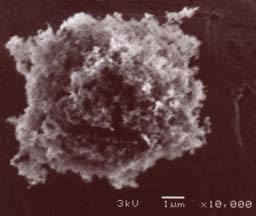Black soot and snow: A warmer combination

SOOT PARTICLE UNDER A MICROSCOPE <br>Credit: D.M. Smith, University of Denver <br>
New research from NASA scientists suggests emissions of black soot alter the way sunlight reflects off snow. According to a computer simulation, black soot may be responsible for 25 percent of observed global warming over the past century.
Soot in the higher latitudes of the Earth, where ice is more common, absorbs more of the sun’s energy and warmth than an icy, white background. Dark-colored black carbon, or soot, absorbs sunlight, while lighter colored ice reflects sunlight.
Soot in areas with snow and ice may play an important role in climate change. Also, if snow- and ice-covered areas begin melting, the warming effect increases, as the soot becomes more concentrated on the snow surface. “This provides a positive feedback (i.e. warming); as glaciers and ice sheets melt, they tend to get even dirtier,” said Dr. James Hansen, a researcher at NASA’s Goddard Institute for Space Studies, New York.
Hansen and Larissa Nazarenko, both of the Goddard Institute and Columbia University’s Earth Institute, found soot’s effect on snow albedo (solar energy reflected back to space), which has been neglected in previous studies, may be contributing to trends toward early springs in the Northern Hemisphere, thinning Arctic sea ice, melting glaciers and permafrost. Soot also is believed to play a role in changes in the atmosphere above the oceans and land.
“Black carbon reduces the amount of energy reflected by snow back into space, thus heating the snow surface more than if there were no black carbon,” Hansen said.
Soot’s increased absorption of solar energy is especially effective in warming the world’s climate. “This forcing is unusually effective, causing twice as much global warming as a carbon-dioxide forcing of the same magnitude,” Hansen noted.
Hansen cautioned, although the role of soot in altering global climate is substantial, it does not alter the fact greenhouse gases are the primary cause of climate warming during the past century. Such gases are expected to be the largest climate forcing for the rest of this century.
The researchers found that observed warming in the Northern Hemisphere was large in the winter and spring at middle and high latitudes. These observations were consistent with the researchers’ climate model simulations, which showed some of the largest warming effects occurred when there was heavy snow cover and sufficient sunlight.
Hansen and Nazarenko used a leading worldwide-climate computer model to simulate effects of greenhouse gases and other factors on world climate. The model incorporated data from NASA spacecraft that monitor the Earth’s surface, vegetation, oceans and atmospheric qualities. The calculated global warming from soot in snow and ice, by itself in an 1880-2000 simulation, accounted for 25 percent of observed global warming. NASA’s Terra and Aqua satellites are observing snow cover and reflectivity at multiple wavelengths, which allows quantitative monitoring of changing snow cover and effects of soot on snow.
The research is in the paper “Soot Climate Forcing via Snow and Ice Albedos,” appearing online this week in the Proceedings of the National Academy of Sciences.
This research was funded by NASA’s Earth Science Enterprise. The Enterprise is dedicated to understanding the Earth as an integrated system and applying Earth system science to improve prediction of climate, weather and natural hazards using the unique vantage point of space.
Media Contact
More Information:
http://www.gsfc.nasa.gov/topstory/2003/1223blacksoot.htmlAll latest news from the category: Earth Sciences
Earth Sciences (also referred to as Geosciences), which deals with basic issues surrounding our planet, plays a vital role in the area of energy and raw materials supply.
Earth Sciences comprises subjects such as geology, geography, geological informatics, paleontology, mineralogy, petrography, crystallography, geophysics, geodesy, glaciology, cartography, photogrammetry, meteorology and seismology, early-warning systems, earthquake research and polar research.
Newest articles

After 25 years, researchers uncover genetic cause of rare neurological disease
Some families call it a trial of faith. Others just call it a curse. The progressive neurological disease known as spinocerebellar ataxia 4 (SCA4) is a rare condition, but its…

Lower dose of mpox vaccine is safe
… and generates six-week antibody response equivalent to standard regimen. Study highlights need for defined markers of mpox immunity to inform public health use. A dose-sparing intradermal mpox vaccination regimen…

Efficient, sustainable and cost-effective hybrid energy storage system for modern power grids
EU project HyFlow: Over three years of research, the consortium of the EU project HyFlow has successfully developed a highly efficient, sustainable, and cost-effective hybrid energy storage system (HESS) that…





















